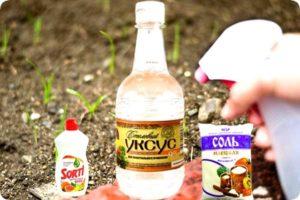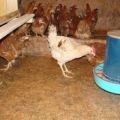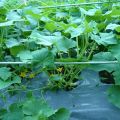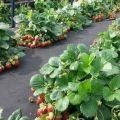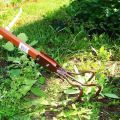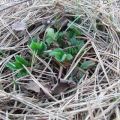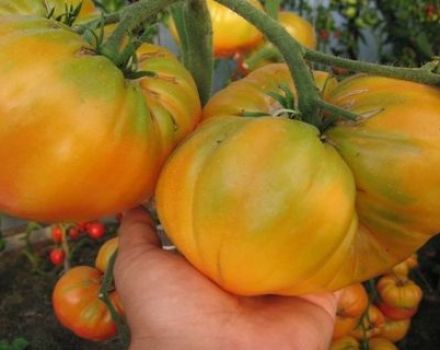Varieties of covering material for weed control and how to use it correctly
Weeding is often used to combat weeds, although gardeners will not call this activity easy and enjoyable. But the task of caring for the beds can be facilitated with the help of a covering material from weeds. Today on the market you can find high quality flooring in different price categories. The covering material makes the beds neat and well-groomed, while not inhibiting the growth of cultivated plants.
The principle of operation of the covering material
The material that covers the beds and flower plantations does not allow sunlight to pass through, which is necessary for weeds for life. Weeds cannot break through to the light, biochemical reactions are disrupted in their tissues, the root system dries out. Plants die.
So that only the weeds are affected, and the cultivated species remain unharmed, the fabric is carefully laid on the beds, fixed, holes are cut in places corresponding to the location of cultivated plants.
Modern types of ground cover not only reliably protect against the growth of weeds, but also do not provoke root decay, the development of fungal diseases. They can not only cover the beds and flower beds, but also cover the paths on the personal plot in order to prevent weeds from breaking through between the plates. A denser material is placed between the beds to maintain the neat condition of the site.
The dense cover helps to get rid of soil pests. Insects have difficulties with orientation in space, they cannot reproduce.

Advantages and disadvantages
The main advantage of using a covering material is to facilitate the task of caring for vegetable, berry, and flower crops. Ground covering is popular because:
- protects the upper soil layer from adverse environmental conditions, prevents plants from withering away from lack of moisture and nutrients, excess sunlight, heavy rainfall;
- creates microclimatic conditions ideal for the development of cultivated vegetation, but unfavorable for the reproduction of a bacterial infection;
- simplifies the implementation of activities for the care of cultivated plants;
- suitable for use both in an open area and in a greenhouse;
- due to its dense structure, it has a long service life (up to 8-12 seasons), does not lose quality and appearance during operation.
The disadvantages of the covering fabric are due to its improper use:
- If a weed cover is installed or operated incorrectly, then a greenhouse effect occurs under it.And excessive humidity, in the absence of air circulation, provokes the development of a fungal infection.
- A dark colored cloth gets very hot under the sun, and the UV stabilizing layer becomes ineffective after 2 months of use. Therefore, in the climatic conditions of the southern regions, hay, sawdust, newsprint are used to protect plantings.

Types of Nonwoven Weed Covering Materials
Agrocloth for weeds is sold on the market in a very different category of quality and price. You can choose a product according to color, density, structure and other preferences and needs.
Spunbond
The brand became so popular that summer residents began to call this word any covering material for beds. Spunbond is a special fabric production technology. It turns out to be light, airy, but we fix it. The material is environmentally friendly, it is not affected by temperature fluctuations and mechanical stress.
Spunbond is white and black in color, in density - 20-60 g / m2:
- White material up to 30 g / m22, are used mainly to protect crops from recurrent spring cold and abundant sunlight in summer. They cover seedlings, berries, decorative species, flower beds. And young seedlings of spunbond fruit trees protects against harmful insects.
- White linen 30-50 g / m22, suitable for winter protection of any ornamental and fruit crops. It is also pulled over an arc frame greenhouse or greenhouse.
- Black spunbond 50-60 g / m2 with a UV-stabilizing layer reliably protects against weeds, contributes to the receipt of more heat by cultivated plants.

Geotextile
Geofabric, which is based on polyester fibers, woven under thermal influence, is characterized by strength and the ability to breathe. The popularity of the product is due to:
- long service life;
- versatility of application;
- ease of installation on site;
- low cost.

Agrospan
In fact, a kind of spunbond produced by the Russian company Ayaskom. The same high quality, durable, inexpensive. It is mainly used for sheltering strawberries, strawberries and other berries.
Agrotextile has a UV-stabilizing layer, wears out slowly, is not susceptible to temperature fluctuations.
Therefore, it is used as a winter shelter, but also shows itself perfectly as a means of protection against weeds.
Agrotex
Another popular type of covering material from a Russian manufacturer. Available in two colors:
- yellow - intended for the destruction of pests on nightshade plants;
- black - a weed control agent, used mainly on strawberry plantations.
The material has a perforated structure, so there is no need to cut holes for crops. It is enough to cover the plot in the garden, and the cultural plantings will not suffer from high temperatures, get dirty with soil during irrigation and precipitation. Agrotex does not wrinkle, is not afraid of temperature fluctuations, does not provoke soil damage by a bacterial infection.

Agril
Breathable fabric designed specifically for weed control. Sheltered plants do not wither from the heat, do not freeze during the cold period. The covered soil remains loose, does not undergo crust-forming and erosion processes, the biochemical component is not disturbed in it, oxygen and nutrition continue to be fully absorbed by the roots. With proper use of the material, cultivated plants yield earlier crops. You can use agryl for mulching strawberries, vegetable beds.
For weed control, a black material with a density of 50 g / m2 is used2... For greenhouse equipment, they take a transparent fabric with a density of 20-40 g / m2.

Lumitex
It is a corrugated film coating of soft structure and different colors. Due to its ability to reflect harmful and transmit the sun's rays beneficial to plants, even in cloudy weather, agrofibre is used to shelter cucumber and berry beds, does not provoke overheating and hypothermia of plants, and accelerates the ripening of fruits.
When equipping a greenhouse, you can combine lumitex with plastic wrap.
Lutrasil
Usually used for cold protection, but can be a good weed control. The material is of high quality, it costs a little more than spunbond, in quality it is actually similar to it. Available in two color variations - white and black. Density - from 20 to 60 g / m22.
The coating is applied:
- low density white - to protect seedlings and seedlings from spring frosts;
- high density white - as a winter shelter (in frosts up to 8-10 ° C);
- medium to high density black - against weeds.

Black film
Before the advent of agrotextiles, black sheeting was the only material to shelter the soil from weeds. It darkens well. It can cover not only the beds, but the aisles.
Today, the film is significantly inferior to modern agricultural fabrics:
- does not let water through;
- creates a greenhouse effect, which increases the likelihood of a fungal infection;
- has a short service life.

How are covering materials used?
Below is a step-by-step guide to using the Weed Control Cover. Need to:
- Use any method to clear the area from weeds.
- Apply fertilizer. Level the ground.
- Cut off a piece of canvas according to the size of the area with an allowance for fastening of 15 cm.
- Cut holes for cultivated plants in the form of crosses or circles.
- In calm weather, cover the site with material.
- Fasten the allowances with stones in the dug grooves or cover them with earth.
- At different points of the site, attach the material to the soil with wire pins 10 cm long.
- Sow seeds into the holes, plant seedlings.
How to water covered plants?
The modern covering material allows water to pass freely.
Watering is carried out by the irrigation method, the canvas does not need to be removed. Liquid fertilizer is carefully poured into the hole.
To prevent waterlogging of the soil and decay of plants, the moisture level is checked through the cut hole.
The popularity of agrotextiles among farmers and summer residents is not surprising. Easy to use, breathable, durable, resistant to adverse factors, the material allows you to forget about the existence of weeds for the whole season. It is also inexpensive.
